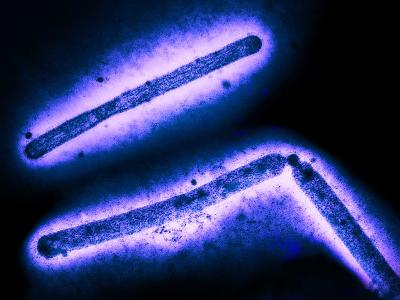Two strains of bacteria resistant to different antibiotics can protect each other in an environment where both drugs are present, according to the first experimental study of microbial cross-protection published last week in Proceedings of the National Academy of Sciences (PNAS).
Researchers from the Massachusetts Institute of Technology (MIT) Department of Physics explored the potential of mutualism—an interaction that benefits two different species—on two strains of Escherichia coli, one of which was resistant to ampicillin and the other resistant to chloramphenicol.
Though the type of mutualism known as cross-protection, in which species depend on each other for survival in a challenging environment, has been observed in larger animals, it has not previously been observed experimentally in bacterial populations, the authors noted.
Cross-protection in drug-resistant E coli depended on a host of factors, including characteristics of each resistant strain, presence and amount of antibiotics, dilution and oscillation of bacterial population abundance, and invasion by other bacteria.
The role of enzyme deactivation
Strains of E coli express antibiotic resistance by producing defensive enzymes that destroy the drug. Resistant strains can often protect drug-susceptible pathogens through enzyme deactivation if they are able to quickly remove the antimicrobials from the environment, the authors said.
During a 10-day experiment, researchers exposed an ampicillin-resistant and a chloramphenicol-resistant E coli strain to mixed concentrations of the antibiotics that should have killed each strain alone. Ampicillin-resistant E coli cannot survive alone in a chloramphenicol concentration above 2.2 micrograms per milliliter (mcg/mL), and a chloramphenicol-resistant strain will be destroyed when exposed to 2 mcg/mL of ampicillin.
Even when bacterial populations were diluted each day by transferring 1% of the colonies to a new test tube containing antibiotics, the strains were able to protect each other against drug concentrations fourfold higher than amounts lethal to one strain alone.
"A coculture of the two strains can survive above the concentrations at which the individual strains survive alone, indicating that the two populations form an obligatory mutualism," the authors wrote.
Oscillation and collapse
A key contributor to cross-protection between two resistant bacterial strains was each population's ability to oscillate in size when diluted daily in a solution containing ampicillin and chloramphenicol. Oscillation cycles lasted for 3 days and involved massive changes in the percentage of each strain while the total size of the bacterial population remained stable.
During a 3-day oscillation cycle, the ampicillin-resistant strain grew in abundance as it deactivated the antibiotic. This activity allowed the chloramphenicol-resistant strain to grow, removing chloramphenicol from the environment, until the ampicillin-resistant strain could increase again, thus continuing a cycle in which the strains protected and overtook each other in abundance. Populations varied by up to 1,000% over the 3-day range, the authors said.
Oscillations in abundance occurred because of the daily dilution in an antibiotic-rich environment and were not related to different natural growth rates in each strain, the author said. The cross-protective effect achieved by the oscillations appeared stable, with shifts in each strain's growth and relative proportion likely being sustainable over time.
"Because these oscillations occurred with a period (3 days) longer than the period of the daily dilution (1 day), they were not a trivial consequence of the daily growth-dilution cycle," the authors said.
Oscillation cycles had to be precisely balanced to prevent the cross-protective interaction's total collapse. At chloramphenicol concentrations of 7.6 mcg/mL, both bacterial populations were able to achieve stable oscillations and coexist. When exposed to chloramphenicol levels of 17.1 mcg/mL, however, the oscillations became erratic, the sustainable 3-day cycle was lost, and the interaction collapsed, the probability of which increased at chloramphenicol concentrations of 38.4 mcg/mL.
Frequently diluting small concentrations of bacteria in media containing 10 mcg/mL of ampicillin and 5.1 mcg/mL of chloramphenicol allowed the bacterial populations to form a stable cross-protective relationship.
"In a continuous culture experiment in which the antibiotics are continuously added (and cells continuously removed), there will be no oscillations in the population abundances, and instead the ratio between the two strains should approach a stable equilibrium," the authors wrote.
Double-resistance invasion
The introduction of an individual E coli strain resistant to both antibiotics also caused the cross-protective behavior to collapse, the authors said.
When researchers added a small number of double-resistant E coli cells to the dilutions at the beginning of the seventh growth cycle, the double-resistant strain displaced the ampicillin-resistant E coli and co-existed with the chlorampenicol-resistant strain in a solution containing concentrations of ampicillin at 10 mcg/mL and chloramphenicol at 7.5 mcg/mL.
"A double-resistant strain can invade the mutualism and cause the oscillations to vanish, illustrating that the existence of oscillations depends on how resistance is allocated in the microbial population," the authors said.
In the absence of a multi–drug-resistant microbial invasion, horizontal gene transfer in the cross-protective co-culture could create a double-resistant mutant strain, the authors said. In addition, "the cooperative nature of antibiotic deactivation could allow a sensitive strain to use the two mutualists for protection."
Implications for infection and resistance
Because cross-protection often arises as a strategy to help survive a harsh environment, greater understanding is needed about both the environment and the microbial population dynamics, including the role of oscillations in strain abundance, under which mutualistic behavior allows bacterial resilience in the presence of antibiotics. The authors note that little knowledge is available about the role and cause of oscillations in stabilizing population abundance even as they occur in more easily observable organisms, such as the Canada lynx and snowshoe hare.
Many cross-protective relationships are the result of two organisms co-evolving in the same environment, though this is not the case with E coli strains. Mutualistic behavior in this case is thought to arise as a result of exposure to antibiotics, the authors said.
"Whether an interaction is cooperative or competitive can depend on the environment," the authors wrote, adding that exposing cross-protective strains to antibiotics can fuel the development of multi-drug resistance by buying time for further evolutionary adaptation.
See also:
May 17 PNAS study
May 16 MIT press release
























